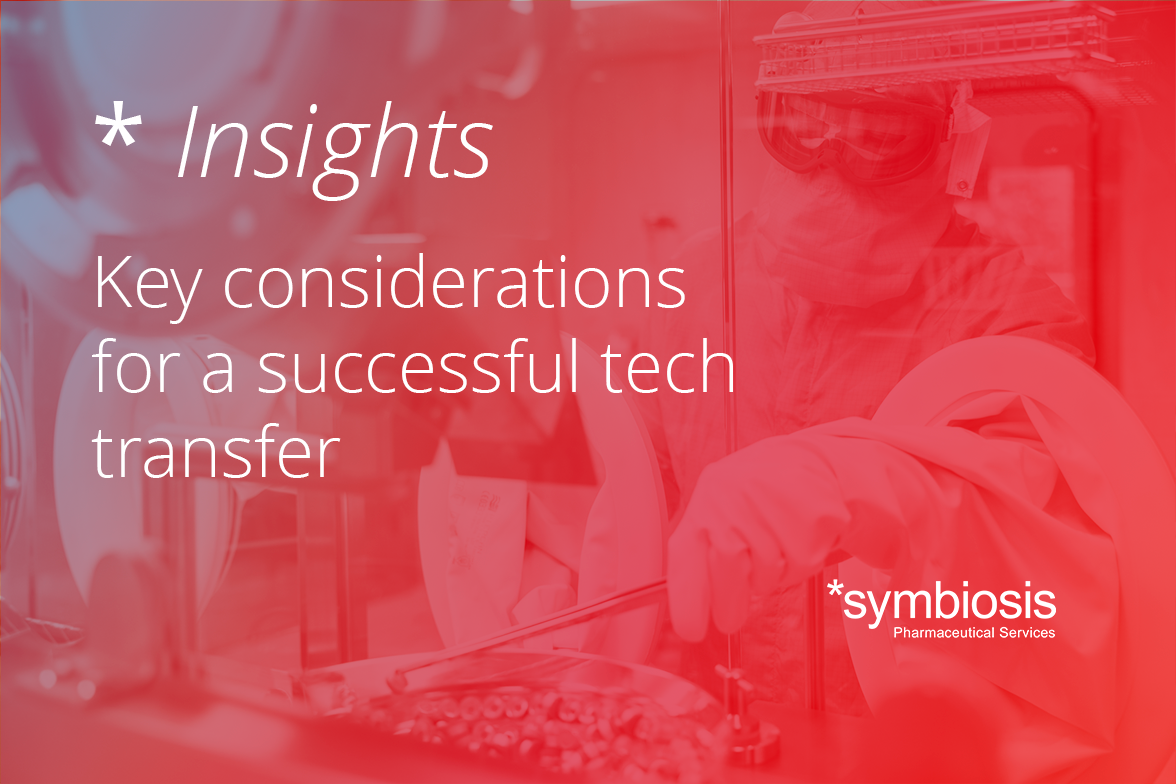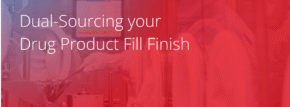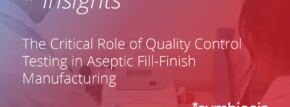Key considerations for a successful tech transfer
Speed is essential in today’s pharmaceutical development. Bringing a new drug to market quickly can be the difference between meeting a critical patient need and missing a crucial window of opportunity.
An efficient and timely tech transfer can be crucial for drug developers partnering with a contract manufacturing organisation (CMO) or moving processes between or within facilities. Successfully navigating tech transfer is the key to a seamless transition to the next stage of drug development and quick delivery of life-saving treatments to patients. CMOs with extensive experience and expertise can help developers achieve a smooth tech transfer and right-first-time results without delays.
This blog breaks down the key stages of drug development where tech transfer would be required, showing the importance of a streamlined yet thorough approach. It also explains what needs to be shared as part of a tech transfer, introduces the key players involved in the process and the importance of post-transfer monitoring and support.
When is a tech transfer required?
Tech transfer is a recurring need throughout the product life cycle, ensuring smooth transitions between development stages, manufacturing scale and different organisations. It typically takes place at these points:
- Preclinical trial stages to Phase I of clinical trials:
This involves transferring the manufacturing process from a small-scale lab setting to a pilot plant or CMO capable of producing material for initial human trials. At this stage, the focus should be on ensuring compliance with good manufacturing practices (GMP) and generating sufficient quantities of drug product (DP) with consistent quality for Phase 1 studies. - Phase II to Phase III of clinical studies:
This stage often involves scaling up the manufacturing process to accommodate larger clinical trials and potential future commercial demand. It is important to optimise the process for efficiency and cost-effectiveness while maintaining quality and consistency. This may involve transferring knowledge to a larger-scale facility of a CMO with greater capacity. - Phase III to regulatory submission:
At this point, the finalised manufacturing process is transferred to the commercial manufacturing site, for example, a CMO’s site. It is vital to ensure that this process is robust, reproducible and fully compliant with GMP regulations. This transfer is critical for supporting regulatory approval. - Post-approval:
Tech transfer may occur after regulatory approval for various reasons, such as scaling production up or down to adjust to market demand, transferring to a different CMO due to cost, capacity or strategy or introducing process improvements. The focus should be on maintaining product quality and consistency while adapting to evolving market needs and optimising manufacturing processes. - Pharmacovigilance post-commercialisation:
While not a “traditional” tech transfer, knowledge transfer is essential for ongoing pharmacovigilance. This involves sharing information about the product and its manufacturing process with safety monitoring and risk management teams. It is crucial to ensure the long-term safety and efficacy of the treatment by facilitating continuous monitoring and rapid response to any emerging safety concerns.
By understanding the considerations for tech transfer at each stage, drug developers can navigate these transitions effectively.
So what is included in a tech transfer?
For a tech transfer to be smooth and successful, it is essential to have clear and comprehensive information. This includes a detailed breakdown of the manufacturing process, product specifications and quality standards. The key elements involved include:
- Process description, including step-by-step instructions, process flow diagrams, executed batch records, standard operating procedures (SOPs), a process development report and annual product reviews
- Product information, with drug substance (DS) details, critical quality attributes (CQAs) and quality standards
- Analytical methods, which include analytical procedures, method validation data, reference standards and test-method development reports
- Technology and equipment, including detailed specifications, process control strategies and cleaning and validation methods
- Quality and regulatory information, with quality management systems (QMS), regulatory filings information and stability data
- Packaging materials and process specifications, ensuring the product’s protection and stability
- Training and support, including training materials, on-site support and ongoing communication and collaboration
How important are documents and quality systems?
Diligent documentation and robust quality systems are vital in guaranteeing seamless tech transfers. Comprehensive and well-organised records and quality procedures ensure the final product is safe and effective.
Development reports must be detailed, unambiguous and contextualised to prevent misinterpretations and errors during tech transfers. Insufficient or unclear information can cause challenges at further manufacturing stages. Any discrepancies in SOPs, testing protocols, manufacturing batch records and lab notebooks can compromise production processes and impact the quality of the DP, potentially resulting in delays, wastage or safety concerns. Inadequate documentation of manufacturing processes and analytical testing can lead to inconsistencies and errors when replicating processes at the receiving site.
CMOs may work with diverse clients, each with unique requirements and procedures. This variability can create challenges in keeping standardised processes and documentation. Standardisation at the receiving site — offered by specialised and experienced CMOs — fosters consistency and efficiency and reduces the risk of errors, ultimately benefiting project progress and timelines and driving productivity and operational excellence improvements.
Who should be in the tech transfer team?
Assembling a high-performing tech transfer team will determine the success of the transfer and the overall project. A well-structured CMO tech transfer team will have a diverse range of expertise, strong leadership and clearly defined roles and responsibilities to ensure a seamless and efficient transfer.
- The project manager is the central coordinator and should be the single point of contact for any and all project communications between client and CMO. They will oversee all transfer aspects including planning, execution and progress monitoring and reporting.
- Cross-functional subject matter experts with in-depth knowledge of the manufacturing process, analytical methods and quality standards are also essential. They may include researchers and engineers who can provide technical guidance and ensure the integrity of the transfer process.
- Quality assurance and quality control personnel are critical in adhering to GMP and established quality standards throughout the transfer.
- Regulatory affairs specialists provide guidance on relevant requirements and ensure compliance with all necessary submissions and approvals.
- Manufacturing and operations team members can help ensure a smooth transition and ongoing operational efficiency.
Each team member’s roles and responsibilities should be clearly defined. Establishing dedicated teams at both the sending and receiving sites improves communication, coordination, and oversight of the tech transfer process. Smaller drug developers, especially start-ups, may need additional specialist support in collating and transferring the necessary information. For complex or novel projects, CMOs may also need to engage their curated selection of expert specialists outside of their core team to ensure adequate expertise in planning and executing tech transfers.
What about post-transfer monitoring and support?
The success of a tech transfer goes beyond the initial transfer of knowledge and processes. Post-transfer monitoring and support constitute a critical phase in ensuring the long-term efficacy and sustainability of the transferred technology. Ongoing commitment to collaboration helps organisations achieve and maintain the desired product quality and process efficiency.
Despite meticulous planning, there may be unforeseen challenges during the initial manufacturing runs at the receiving facility. Continuous monitoring helps your CMO proactively identify deviations or quality concerns and intervene quickly. This prevents issues from escalating and jeopardising product quality, timelines or approvals. Monitoring generates valuable data and insights that can be used to optimise processes and help the receiving team better understand them. It also ensures continued compliance and adherence to GMP and other regulatory requirements, including post-approval changes. Ongoing communication and support with a CMO’s dedicated points of contact build a solid, collaborative partnership between the sending and receiving units, cultivating trust.
Streamlining tech transfer for rapid drug development
Rapid tech transfer enables drug developers to meet critical patient needs faster, but requires a solid understanding of the key stages where transfer is required and implementing a streamlined approach. A successful tech transfer necessitates comprehensive documentation, robust quality systems and a skilled cross-functional team.
Partners who can work collaboratively with developers and offer rapid access to manufacturing slots can help reduce manufacturing timelines from years to months or even weeks. This can make all the difference to patients waiting for life-saving treatments.
To learn more about conducting successful tech transfers and discover how an experienced CMO can help guide you through the process, read the Symbiosis eBook, Tech transfers: Commercialising your drug product.



